Spatiotemporal Patterns of Desertification Dynamics and Desertification Effects on Ecosystem Services in the Mu Us Desert in China
Abstract
:1. Introduction
2. Materials and Methods
2.1. Study Area
2.2. Data Sources
2.3. Data Analysis
2.3.1. Climate Change in Mu Us Desert from 1985 to 2013
2.3.2. Desertification Difference Index (DDI)
Albedo (OLI) = 0.356·ρ2 + 0.130·ρ4 + 0.373·ρ5 + 0.085·ρ6 + 0.072·ρ7 − 0.0018
2.3.3. Quantification of Ecosystem Services in the Mu Us Desert
Water Retention (WR)
Net Primary Productivity (NPP)
Crop Productivity (CP) and Livestock Productivity (LP)
3. Results
3.1. Climate Change in Mu Us Desert from 1985 to 2013
3.2. Dynamic of Spatial Pattern of Desertification from 1986 to 2015
3.3. Spatial Pattern of Ecosystem Services
3.4. Relationships between Ecosystem Services
3.5. Effects of Desertification on Ecosystem Services
4. Discussion and Conclusions
4.1. Desertification Dynamics in 1986–2015
4.2. Relationships between Ecosystem Services
4.3. Impacts of Desertification on Ecosystem Services
Acknowledgments
Author Contributions
Conflicts of Interest
References
- Millennium Ecosystem Assessment. Ecosystems and Human Well-Being; Island Press: Washington, DC, USA, 2005. [Google Scholar]
- Wu, J. Landscape sustainability science: Ecosystem services and human well-being in changing landscapes. Landsc. Ecol. 2013, 28, 999–1023. [Google Scholar] [CrossRef]
- Lavorel, S.; Grigulis, K.; Lamarque, P.; Colace, M.-P.; Garden, D.; Girel, J.; Pellet, G.; Douzet, R. Using plant functional traits to understand the landscape distribution of multiple ecosystem services. J. Ecol. 2011, 99, 135–147. [Google Scholar] [CrossRef]
- UNCCD The Ordos Declaration. UNCCD: Conference of the Parties: Thirteenth Session Ordos, China, 6–16 September 2017. Available online: http://www2.unccd.int/sites/default/files/inline-files/Ordos%20declaration.pdf (accessed on 15 November 2017).
- Wang, X.; Hua, T.; Lang, L.; Ma, W. Spatial differences of aeolian desertification responses to climate in arid Asia. Glob. Planet. Chang. 2017, 148, 22–28. [Google Scholar] [CrossRef]
- Tallis, H.; Kareiva, P.; Marvier, M.; Chang, A. An ecosystem services framework to support both practical conservation and economic development. Proc. Natl. Acad. Sci. USA 2008, 105, 9457–9464. [Google Scholar] [CrossRef] [PubMed]
- Bennett, E.M.; Balvanera, P. The future of production systems in a globalized world. Front. Ecol. Environ. 2007, 5, 191–198. [Google Scholar] [CrossRef]
- Nelson, E.; Mendoza, G.; Regetz, J.; Polasky, S.; Tallis, H.; Cameron, D.R.; Chan, K.M.A.; Daily, G.C.; Goldstein, J.; Kareiva, P.M.; et al. Modeling multiple ecosystem services, biodiversity conservation, commodity production, and tradeoffs at landscape scales. Front. Ecol. Environ. 2009, 7, 4–11. [Google Scholar] [CrossRef]
- McNally, C.G.; Uchida, E.; Gold, A.J. The effect of a protected area on the tradeoffs between short-run and long-run benefits from mangrove ecosystems. Proc. Natl. Acad. Sci. USA 2011, 108, 13945–13950. [Google Scholar] [CrossRef] [PubMed]
- Lester, S.E.; Costello, C.; Halpern, B.S.; Gaines, S.D.; White, C.; Barth, J.A. Evaluating tradeoffs among ecosystem services to inform marine spatial planning. Mar. Policy 2013, 38, 80–89. [Google Scholar] [CrossRef]
- Wang, J.; Peng, J.; Zhao, M.; Liu, Y.; Chen, Y. Significant trade-off for the impact of Grain-for-Green Programme on ecosystem services in North-western Yunnan, China. Sci. Total Environ. 2017, 574, 57–64. [Google Scholar] [CrossRef] [PubMed]
- UNCCD. United Nations Convention to Combat Desertification in Those Countries Experiencing Serious Drought and/or Desertification, Particularly in Africa; UNCCD: Paris, France, 1994. [Google Scholar]
- Symeonakis, E.; Karathanasis, N.; Koukoulas, S.; Panagopoulos, G. Monitoring Sensitivity to Land Degradation and Desertification with the Environmentally Sensitive Area Index: The Case of Lesvos Island. Land. Degrad. Dev. 2016, 27, 1562–1573. [Google Scholar] [CrossRef]
- Lyles, L.; Tatarko, J. Wind Erosion Effects on Soil Texture and Organic Matter. J. Soil Water Conserv. 1986, 41, 191–193. [Google Scholar]
- Field, J.P.; Belnap, J.; Breshears, D.D.; Neff, J.C.; Okin, G.S.; Whicker, J.J.; Painter, T.H.; Ravi, S.; Reheis, M.C.; Reynolds, R.L. The ecology of dust. Front. Ecol. Environ. 2010, 8, 423–430. [Google Scholar] [CrossRef]
- D’Odorico, P.; Bhattachan, A.; Davis, K.F.; Ravi, S.; Runyan, C.W. Global desertification: Drivers and feedbacks. Adv. Water Resour. 2013, 51, 326–344. [Google Scholar] [CrossRef]
- Imeson, A. Desertification, Land Degradation and Sustainability; John Wiley & Sons, Ltd.: Chichester, UK, 2012. [Google Scholar]
- Li, S.; Wang, T.; Yan, C.Z. Assessing the Role of Policies on Land-Use/Cover Change from 1965 to 2015 in the Mu Us Sandy Land, Northern China. Sustainability 2017, 9, 1164. [Google Scholar] [CrossRef]
- Pan, J.; Li, T. Extracting desertification from Landsat TM imagery based on spectral mixture analysis and Albedo-Vegetation feature space. Nat. Hazards 2013, 68, 915–927. [Google Scholar] [CrossRef]
- Zeng, Y.N.; Xiang, N.P.; Feng, Z.D.; Hu, H. Albedo-NDVI Space and Remote Sensing Synthesis Index Models for Desertification Monitoring. Sci. Geogr. Sin. 2006, 26, 75–81. [Google Scholar]
- Liang, S. Narrowband to broadband conversions of land surface albedo I: Algorithms. Remote Sens. Environ. 2000, 76, 213–238. [Google Scholar] [CrossRef]
- Verstraete, M.M.; Pinty, B. Designing optimal spectral indexes for remote sensing applications. IEEE Trans. Geosci. Remote Sens. 1996, 34, 1254–1265. [Google Scholar] [CrossRef]
- Renard, K.G.; Foster, G.R.; Weesies, G.A.; Mccool, D.K.; Yoder, D. Predicting Soil Erosion by Water: A Guide to Conservation Planning with the Revised Universal Soil Loss Equation (RUSLE); United States Government Printing Office: Washington, DC, USA, 1997. [Google Scholar]
- Kareiva, P.; Tallis, H.; Ricketts, T.H.; Daily, G.C.; Polasky, S.; Kareiva, P.; Tallis, H.; Ricketts, T.H.; Daily, G.C.; Polasky, S. Natural Capital: Theory & Practice of Mapping Ecosystem Services; Oxford University Press: Oxford, UK, 2011. [Google Scholar]
- Budyko, M.I. Climate and Life; Academic Press: New York, NY, USA, 1974. [Google Scholar]
- Potter, C.S.; Randerson, J.T.; Field, C.B.; Matson, P.A.; Vitousek, P.M.; Mooney, H.A.; Klooster, S.A. Terrestrial ecosystem production: A process model based on global satellite and surface data. Glob. Biogeochem. Cycles 1993, 7, 811–841. [Google Scholar] [CrossRef]
- Zheng, Z.; Fu, B.; Hu, H.; Sun, G. A method to identify the variable ecosystem services relationship across time: A case study on Yanhe Basin, China. Landsc. Ecol. 2014, 29, 1689–1696. [Google Scholar] [CrossRef]
- Wang, Y.H.; Yang, J.R.; Ding, Y.; Ning, Z.P.; Zhang, H.L. Characteristics of Land Cover Change in Mu Us Desert in Recent Years. Bull. Soil Water Conserv. 2008, 28, 53–57. [Google Scholar]
- Yan, F.; Wu, B. Desertification progress in Mu Us Sandy Land over the past 40 years. Arid Land Geogr. 2013, 36, 987–996. [Google Scholar]
- Karnieli, A.; Qin, Z.H.; Wu, B.; Panov, N.; Yan, F. Spatio-Temporal Dynamics of Land-Use and Land-Cover in the Mu Us Sandy Land, China, Using the Change Vector Analysis Technique. Remote Sens. 2014, 6, 9316–9339. [Google Scholar] [CrossRef]
- Pan, D.; Domon, G.; de Blois, S.; Bouchard, A. Temporal (1958–1993) and spatial patterns of land use changes in Haut-Saint-Laurent (Quebec, Canada) and their relation to landscape physical attributes. Landsc. Ecol. 1999, 14, 35–52. [Google Scholar] [CrossRef]
- Serra, P.; Pons, X.; Saurí, D. Land-cover and land-use change in a Mediterranean landscape: A spatial analysis of driving forces integrating biophysical and human factors. Appl. Geogr. 2008, 28, 189–209. [Google Scholar] [CrossRef]
- Napton, D.E.; Auch, R.F.; Headley, R.; Taylor, J.L. Land changes and their driving forces in the Southeastern United States. Reg. Environ. Chang. 2010, 10, 37–53. [Google Scholar] [CrossRef]
- Peng, J.; Xu, Y.Q.; Cai, Y.L.; Xiao, H.L. The role of policies in land use/cover change since the 1970s in ecologically fragile karst areas of Southwest China: A case study on the Maotiaohe watershed. Environ. Sci. Policy 2011, 14, 408–418. [Google Scholar] [CrossRef]
- Jia, X.; Fu, B.; Feng, X.; Hou, G.; Liu, Y.; Wang, X. The tradeoff and synergy between ecosystem services in the Grain-for-Green areas in Northern Shaanxi, China. Ecol. Indic. 2014, 43, 103–113. [Google Scholar] [CrossRef]
- Xu, D.Y.; Kang, X.W.; Qiu, D.S.; Zhuang, D.F.; Pan, J.J. Quantitative assessment of desertification using Landsat data on a regional scale—A case study in the Ordos Plateau, China. Sensors 2009, 9, 1738–1753. [Google Scholar] [CrossRef] [PubMed]
- Felipe-Lucia, M.R.; Comin, F.A.; Bennett, E.M. Interactions among Ecosystem Services across Land Uses in a Floodplain Agroecosystem. Ecol. Soc. 2014, 19. [Google Scholar] [CrossRef]
- Bennett, E.M.; Peterson, G.D.; Gordon, L.J. Understanding relationships among multiple ecosystem services. Ecol. Lett. 2009, 12, 1394–1404. [Google Scholar] [CrossRef] [PubMed]
- Chisholm, R.A. Trade-offs between ecosystem services: Water and carbon in a biodiversity hotspot. Ecol. Econ. 2010, 69, 1973–1987. [Google Scholar] [CrossRef]
- Xu, Y.; Tang, H.; Wang, B.; Chen, J. Effects of land-use intensity on ecosystem services and human well-being: A case study in Huailai County, China. Environ. Earth Sci. 2016, 75. [Google Scholar] [CrossRef]
- Gong, G.; Liu, J.; Shao, Q.; Zhai, J. Sand-Fixing Function under the Change of Vegetation Coverage in a Wind Erosion Area in Northern China. J. Resour. Ecol. 2014, 5. [Google Scholar] [CrossRef]
- Saleh, A.; Fryrear, D.W. Soil roughness for the revised wind erosion equation (RWEQ). J. Soil Water Conserv. 1999, 54, 473–476. [Google Scholar]
- Wight, J.R.; Black, A.L. Range Fertilization: Plant Response and Water Use. J. Range Manag. 1979, 32, 345–349. [Google Scholar] [CrossRef]
- Prince, S.D.; Brown, D.C.E.; Kravitz, L.L. Evidence from rain-use efficiencies does not indicate extensive Sahelian desertification. Glob. Chang. Biol. 1998, 4, 359–374. [Google Scholar] [CrossRef]
- Archimede, H.; Alexandre, G.; Mahieu, M.; Fleury, J.; Petro, D.; Garcia, G.W.; Fanchone, A.; Bambou, J.-C.; Magdeleine, C.M.; Gourdine, J.-L.; et al. Agroecological Resources for Sustainable Livestock Farming in the Humid Tropics. In Sustainable Agriculture Reviews; Springer Science & Business Media: Berlin, Germany, 2014; Volume 14, pp. 299–330. [Google Scholar]
- Lang, L.; Wang, X.; Wang, G.; Hua, T.; Wang, H. Effects of aeolian processes on nutrient loss from surface soils and their significance for sandy desertification in Mu Us Desert, China: A wind tunnel approach. J. Arid Land 2015, 7, 421–428. [Google Scholar] [CrossRef]
- Hirano, T.; Kiyota, M.; Aiga, I. Physical effects of dust on leaf physiology of cucumber and kidney beans plants. Environ. Pollut. 1995, 89, 255–261. [Google Scholar] [CrossRef]
- Sharifi, M.R.; Gibson, A.C.; Rundel, P.W. Surface dust impacts on gas exchange in Mojave Desert shrubs. J. Appl. Ecol. 1997, 34, 837–846. [Google Scholar] [CrossRef]
- Honour, S.L.; Bell, J.N.B.; Ashenden, T.W.; Cape, J.N.; Power, S.A. Responses of herbaceous plants to urban air pollution: Effects on growth, phenology and leaf surface characteristics. Environ. Pollut. 2009, 157, 1279–1286. [Google Scholar] [CrossRef] [PubMed] [Green Version]
- Niemela, J.; Saarela, S.-R.; Soderman, T.; Kopperoinen, L.; Yli-Pelkonen, V.; Vare, S.; Kotze, D.J. Using the ecosystem services approach for better planning and conservation of urban green spaces: A Finland case study. Biodivers. Conserv. 2010, 19, 3225–3243. [Google Scholar] [CrossRef]
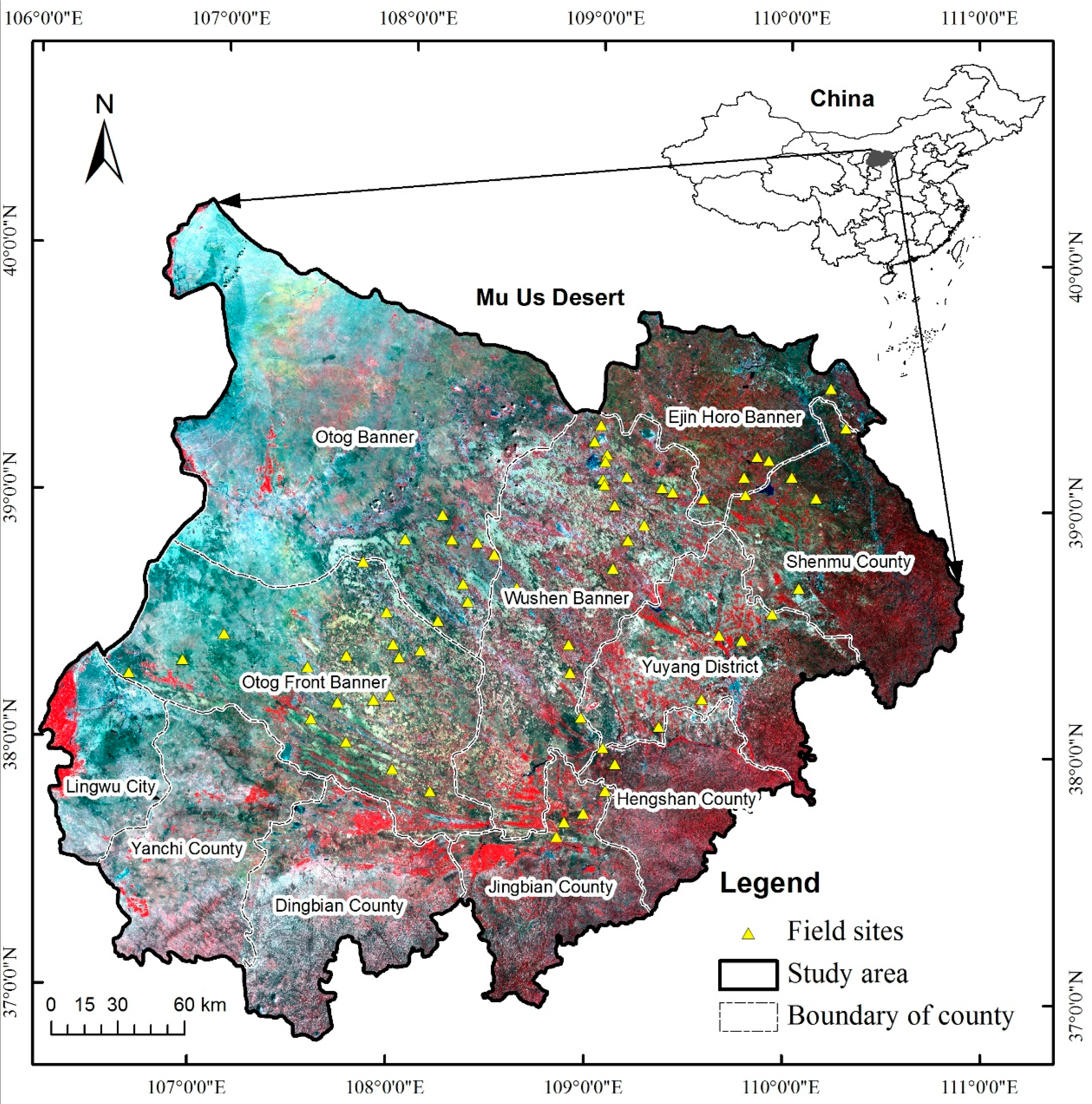
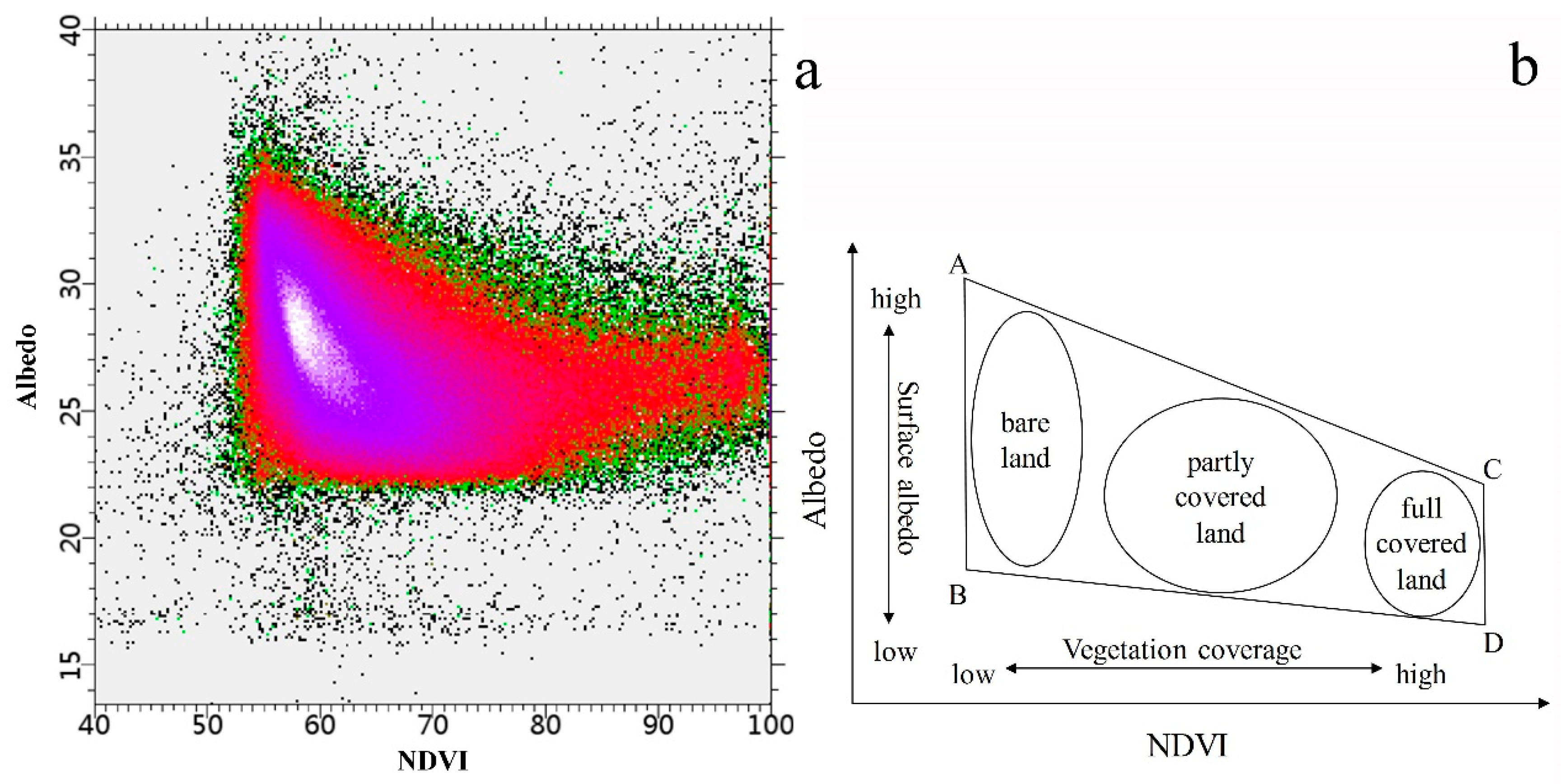

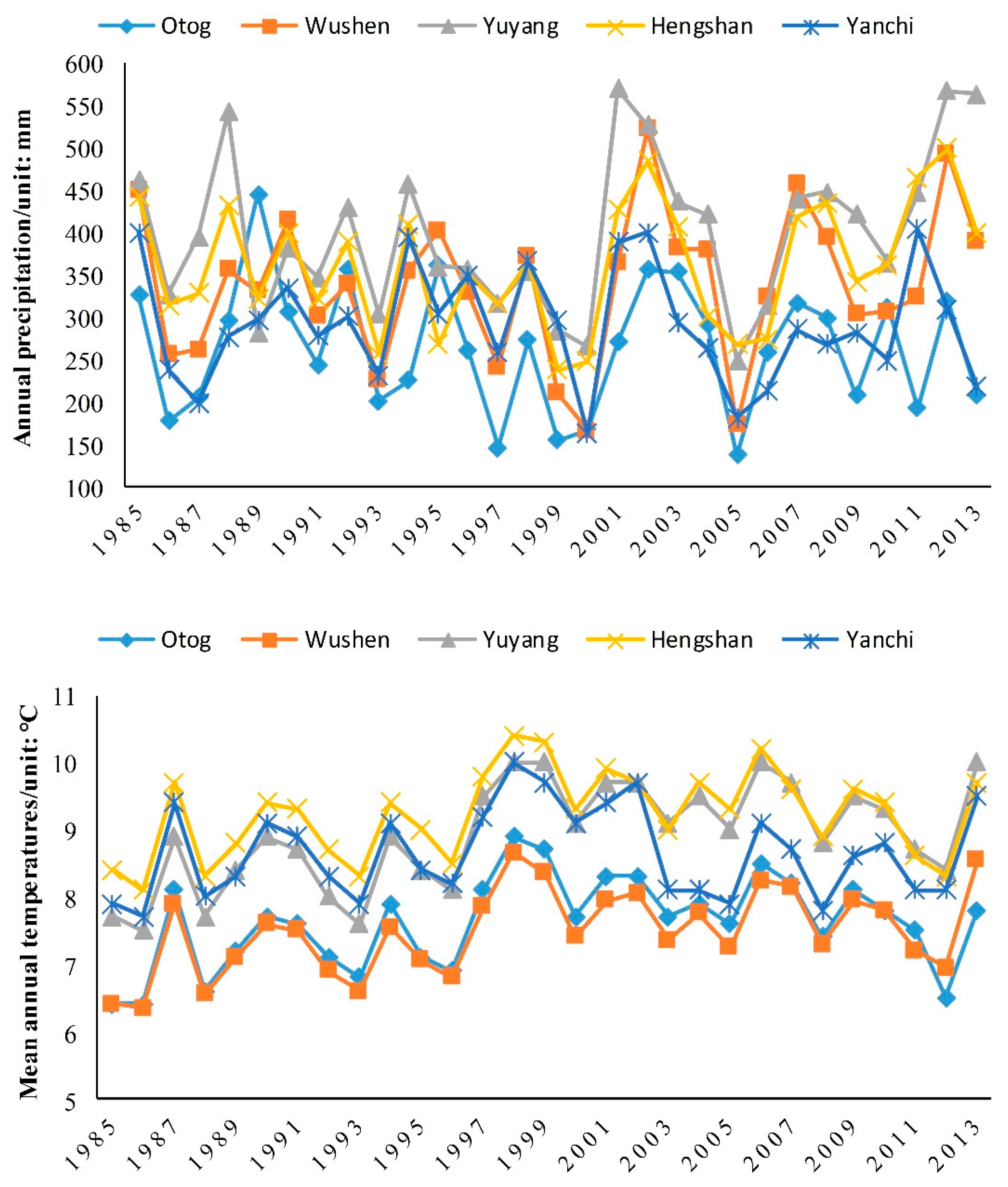
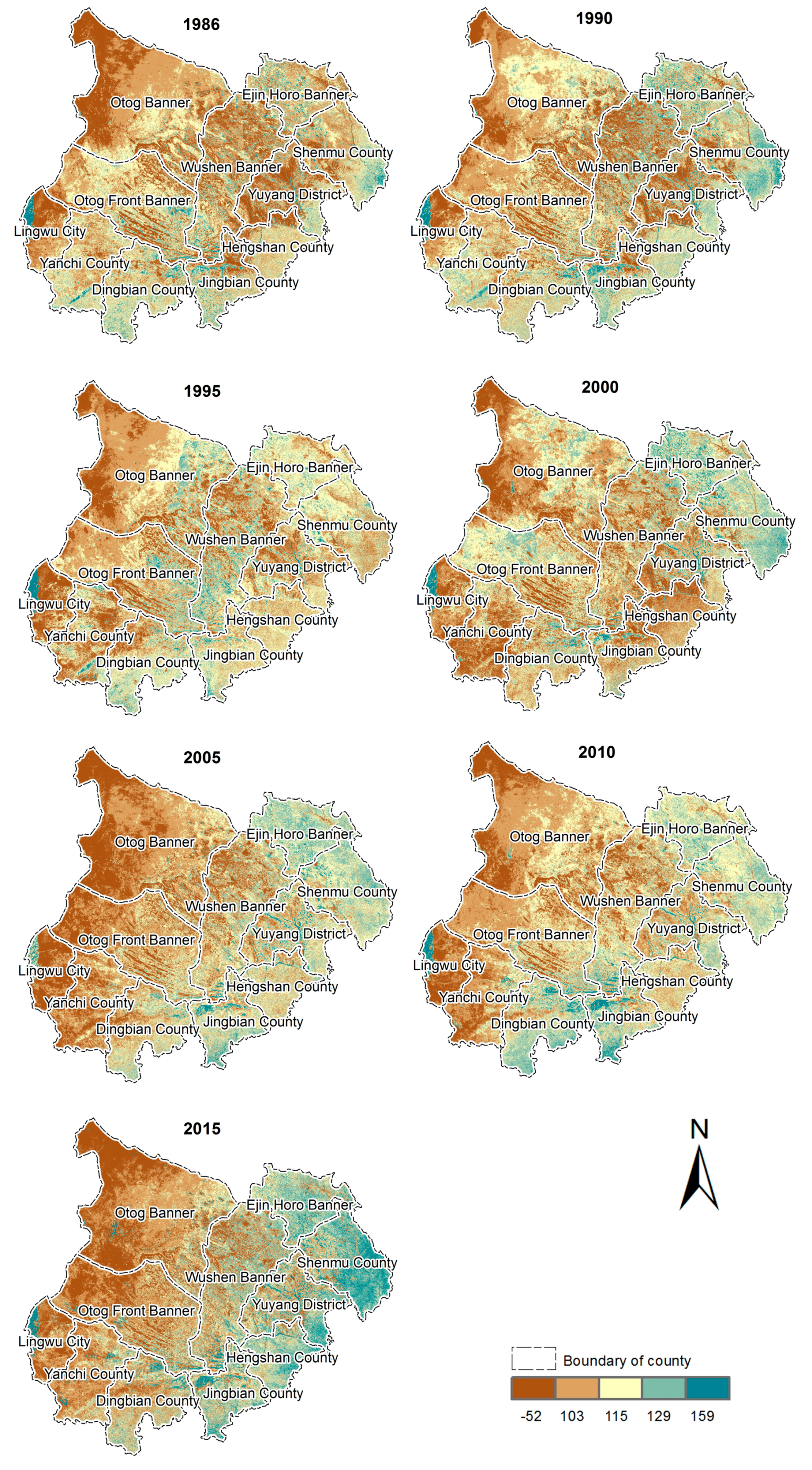
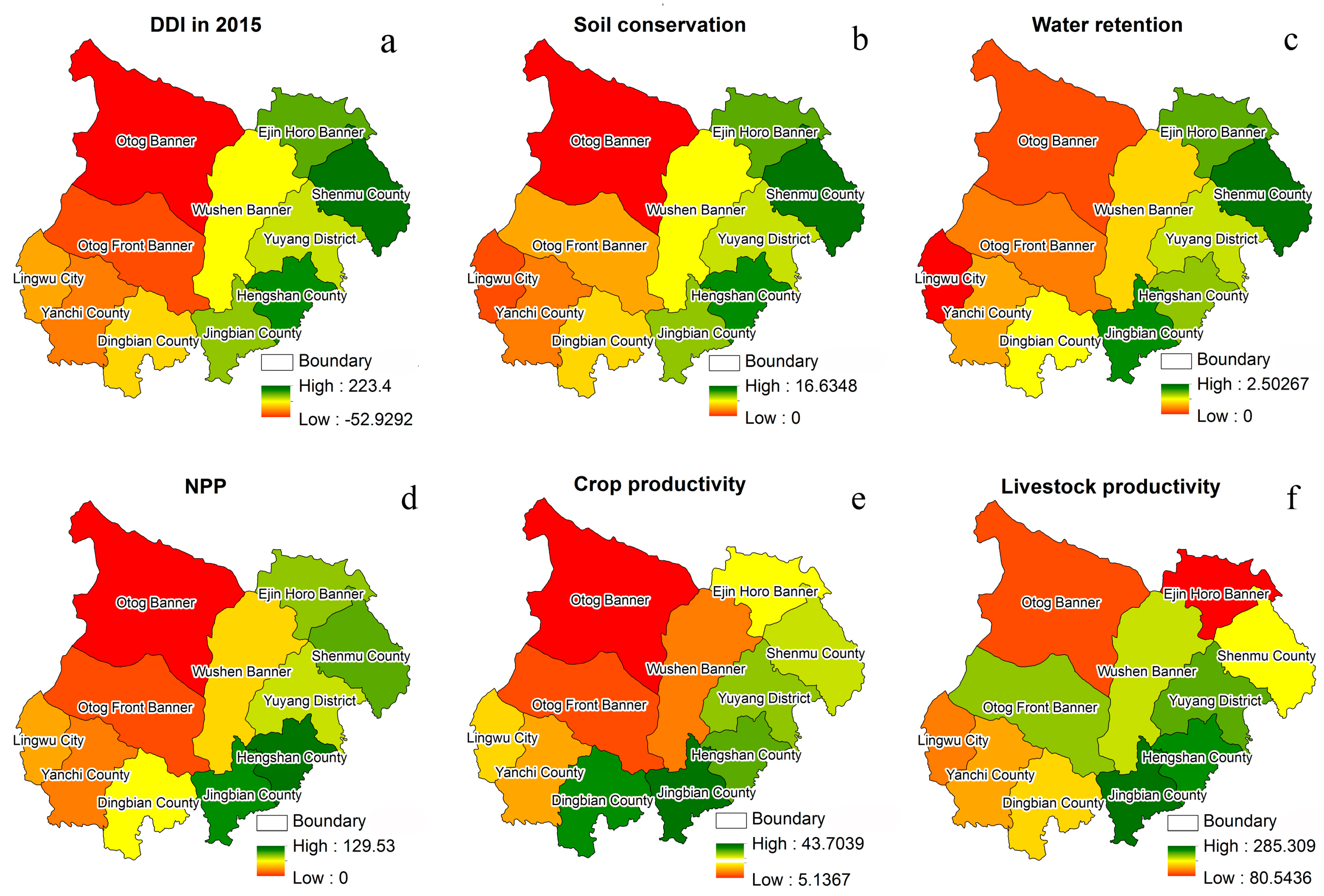


| DDI | Albedo | SBI | SFOI | FVC | NDVI | WI | GI | LST | RUE | |
|---|---|---|---|---|---|---|---|---|---|---|
| MVC | 0.721 ** | −0.714 ** | −0.709 ** | −0.656 ** | 0.583 ** | 0.580 ** | 0.566 ** | 0.393 ** | −0.232 | 0.012 |
| Otog | Wushen | Yuyang | Hengshan | Yanchi | |
|---|---|---|---|---|---|
| Otog | 1 | ||||
| Wushen | 0.744 ** | 1 | |||
| Yuyang | 0.403 * | 0.744 ** | 1 | ||
| Hengshan | 0.447 * | 0.769 ** | 0.869 ** | 1 | |
| Yanchi | 0.377 * | 0.646 ** | 0.585 ** | 0.673 ** | 1 |
| Otog | Wushen | Yuyang | Hengshan | Yanchi | |
|---|---|---|---|---|---|
| Otog | 1 | ||||
| Wushen | 0.975 ** | 1 | |||
| Yuyang | 0.949 ** | 0.963 ** | 1 | ||
| Hengshan | 0.966 ** | 0.961 ** | 0.935 ** | 1 | |
| Yanchi | 0.820 ** | 0.824 ** | 0.729 ** | 0.835 ** | 1 |
| Soil Conservation | Water Retention | NPP | Crop Productivity | Livestock Productivity | |
|---|---|---|---|---|---|
| Soil Conservation | 1 | ||||
| Water Retention | 0.961 ** | 1 | |||
| NPP | 0.897 ** | 0.928 ** | 1 | ||
| Crop Productivity | 0.426 | 0.585 | 0.725 * | 1 | |
| Livestock Productivity | 0.334 | 0.389 | 0.539 | 0.657 * | 1 |
© 2018 by the authors. Licensee MDPI, Basel, Switzerland. This article is an open access article distributed under the terms and conditions of the Creative Commons Attribution (CC BY) license (http://creativecommons.org/licenses/by/4.0/).
Share and Cite
Liu, Q.; Zhao, Y.; Zhang, X.; Buyantuev, A.; Niu, J.; Wang, X. Spatiotemporal Patterns of Desertification Dynamics and Desertification Effects on Ecosystem Services in the Mu Us Desert in China. Sustainability 2018, 10, 589. https://doi.org/10.3390/su10030589
Liu Q, Zhao Y, Zhang X, Buyantuev A, Niu J, Wang X. Spatiotemporal Patterns of Desertification Dynamics and Desertification Effects on Ecosystem Services in the Mu Us Desert in China. Sustainability. 2018; 10(3):589. https://doi.org/10.3390/su10030589
Chicago/Turabian StyleLiu, Qingfu, Yanyun Zhao, Xuefeng Zhang, Alexander Buyantuev, Jianming Niu, and Xiaojiang Wang. 2018. "Spatiotemporal Patterns of Desertification Dynamics and Desertification Effects on Ecosystem Services in the Mu Us Desert in China" Sustainability 10, no. 3: 589. https://doi.org/10.3390/su10030589





